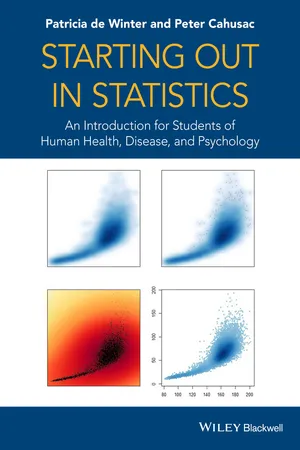
Starting out in Statistics
An Introduction for Students of Human Health, Disease, and Psychology
- English
- ePUB (mobile friendly)
- Available on iOS & Android
Starting out in Statistics
An Introduction for Students of Human Health, Disease, and Psychology
About This Book
To form a strong grounding in human-related sciences it is essential for students to grasp the fundamental concepts of statistical analysis, rather than simply learning to use statistical software. Although the software is useful, it does not arm a student with the skills necessary to formulate the experimental design and analysis of a research project in later years of study or indeed, if working in research.
This textbook deftly covers a topic that many students find difficult. With an engaging and accessible style it provides the necessary background and tools for students to use statistics confidently and creatively in their studies and future career.
Key features:
- Up-to-date methodology, techniques and current examples relevant to the analysis of large data sets, putting statistics in context
- Strong emphasis on experimental design
- Clear illustrations throughout that support and clarify the text
- A companion website with explanations on how to apply learning to related software packages
This is an introductory book written for undergraduate biomedical and social science students with a focus on human health, interactions, and disease. It is also useful for graduate students in these areas, and for practitioners requiring a modern refresher.
Frequently asked questions
Information
1
Introducing Variables, Populations and Samples – ‘Variability is the Law of Life’
1.1 Aims
1.2 Biological data vary
Table of contents
- Cover
- Titlepage
- Copyright
- Dedication
- Introduction – What's the Point of Statistics?
- Basic Maths for Stats Revision
- Statistical Software Packages
- About the Companion Website
- 1 Introducing Variables, Populations and Samples – ‘Variability is the Law of Life’
- 2 Study Design and Sampling – ‘Design is Everything. Everything!’
- 3 Probability – ‘Probability ... So True in General'
- 4 Summarising Data – ‘Transforming Data into Information’
- 5 Statistical Power – ‘… Find out the Cause of this Effect’
- 6 Comparing Groups using t-Tests and ANOVA – ‘To Compare is not to Prove’
- 7 Relationships between Variables: Regression and Correlation – ‘In Relationships … Concentrate only on what is most Significant and Important’
- 8 Analysis of Categorical Data – ‘If the Shoe Fits …’
- 9 Non-Parametric Tests – ‘An Alternative to other Alternatives'
- 10 Resampling Statistics comes of Age – ‘There's always a Third Way’
- Appendix A: Data Used for Statistical Analyses (Chapters 6,7 and 10)
- Appendix B: Statistical Software Outputs (Chapters 6–9)
- Index
- End User License Agreement